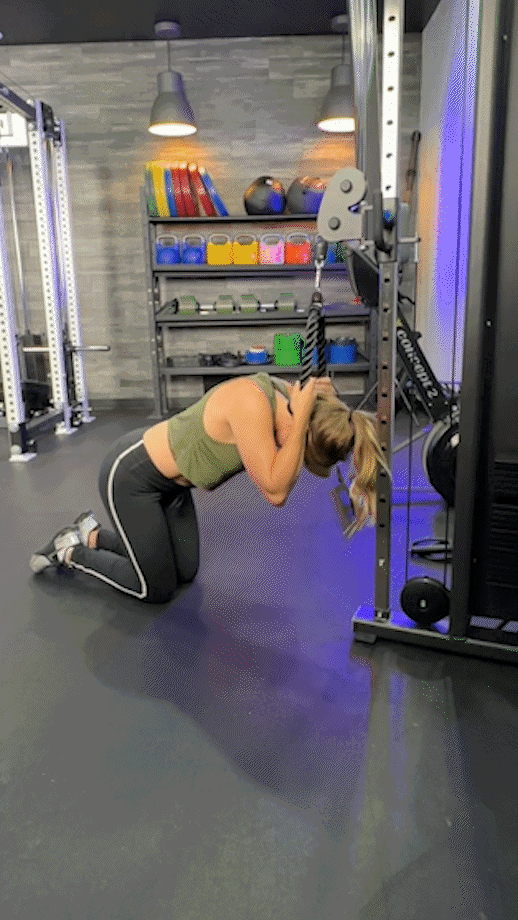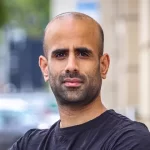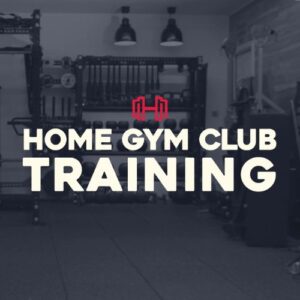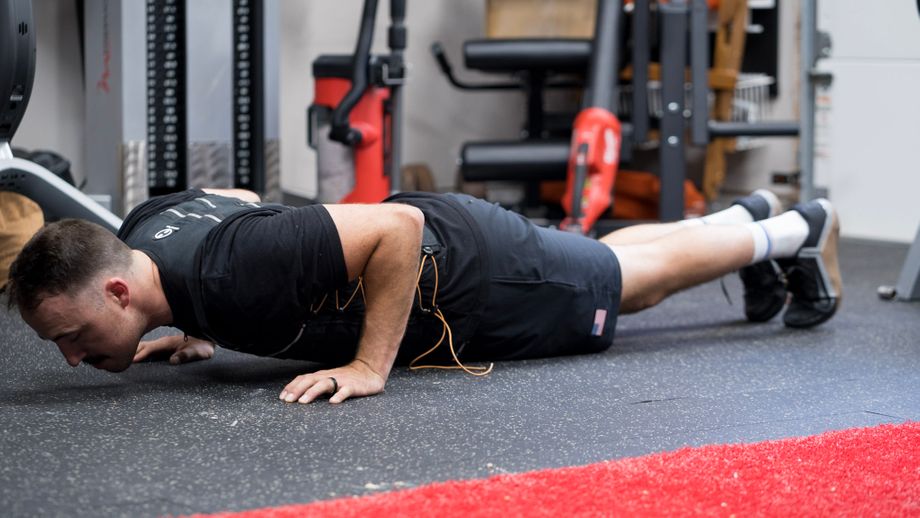Training a single muscle group at a time might work for some people. If that’s you, and you love different types of strength training, who am I to stop you?
Except…it’s not the only way to exercise. Instead, you could combine muscle groups and work them together. This can save time, add variety, and enhance muscle hypertrophy1 because it may lead to increased training volume.
“We’re getting busier as a human race, so it makes sense to make the most out of your workouts by combining muscle groups,” says Kate Meier, certified personal trainer (CPT), USAW-L1, CF-L1, and GGR Head of Content. However, the combinations need to make sense. You can’t just rock up to the gym and throw random pairings together. You’ll need a plan.
RELATED: Superset Workouts: Save Time And Build Strength
That’s my job for today. I’ll be using my experience as a certified personal trainer to explain the seven major muscle groups and then go into the best muscle group combinations to work out together. Within each combination, I’ll go through, step-by-step, how to do each exercise. Let’s get moving!
Major Muscle Groups
I’ll start by explaining the difference between muscles and muscle groups. When it comes to fitness and bodybuilding, muscle groups refer to major areas of the human body, whereas muscles are the specific elements that form that muscle group.
With the chest (which you’ll see below), there are four main muscles that form the chest muscle group. When we talk about “training the chest,” we’re talking about training one or more of these four muscles. Get it? Good. Now, let’s go through the major muscle groups and their function.
RELATED: Best Dumbbell Exercises

Chest
As I mentioned, there are four main muscles in the chest:
- Pectoralis major
- Pectoralis minor
- Serratus anterior
- Subclavius
Collectively, the chest muscles are responsible2 for “flexion, adduction, and internal rotation of the humerus, stabilization of the scapula, as well as elevating and depressing the bones of the thorax,” AKA the chest.
RELATED: Cable Chest Workout
Shoulders
The shoulder muscle group consists of the following muscles:
- Rotator cuffs
- Trapezius
- Deltoid
The shoulder muscles have a wide range of functions3, including “abduction, adduction, flexion, extension, and internal and external rotation.”
Arms
The muscles that make up your arms are:
- Biceps brachii
- Coracobrachialis
- Brachialis
- Triceps (three different heads: long, medial, and lateral)
The arms are responsible4 for supination of the forearm, and flexion and extension of the elbow joint.
RELATED: Dumbbell Triceps Workout
Abdominals
The abdominal muscles5 “assist in the process of respiration, protect the inner organs, provide postural support, and serve to flex, extend, and rotate the trunk of the body.” The main muscle groups are:
- Transversus abdominis
- Internal oblique
- External oblique
- Rectus abdominis
Legs
The leg muscle group consists of the following muscles:
- Quadriceps
- Hamstrings
- Hip flexors
- Adductors/Abductors
- Calves
The quadriceps are responsible for knee extension6, and the hamstrings flex the knee and extend the hip. The hip flexors flex the hip (duh!) and raise the legs. And the adductors pull the thighs together and rotate the upper legs inward. Lastly, the calves help with stability, momentum, and ankle joint flexion.
RELATED: Kettlebell Leg Workout
Back
There are three groups of muscles in the back:
- Intrinsic
- Superficial
- Intermediate
The superficial layer is responsible for moving the shoulder and neck7. The intermediate muscles are the erector spinae, and their function is movement of the thoracic cage and flexion of the upper vertebral column and head. Lastly, the intrinsic muscles stabilize the vertebral column, helping with proprioception (or your sense of movement) and balance.
Glutes
As for the glutes, this posterior area consists of:
- Gluteus maximus
- Gluteus medius
- Gluteus minimus
The larger muscle (gluteus maximus) acts as the “chief antigravity muscle during sitting by counteracting and controlling the flexion of the hip8.” Together, the glutes extend and externally rotate the thigh.
RELATED: Best Resistance Band for Glutes

Best Muscle Groups to Work Out Together
Let’s get into the real reason you’re here. To find the best muscle groups to work out together, of course. Below are three of my favorite trainer-approved combinations, including examples of exercises and how to do them properly.
Chest And Back
The benefits of training the chest and back together can include quicker workouts, more training volume (therefore more potential muscle growth), and training variety.
RELATED: Chest and Back Workout
1A. Chest Exercise: Incline Dumbbell Chest Press
Why do it: “[Incline dumbbell chest press is] a popular weightlifting exercise that helps build muscle in your chest, especially the upper part of it,” explains Kate Meier, CPT, USAW-L1, CF-L1. “Some people find the incline version easier on the shoulder joints when compared to the flat bench dumbbell press.”
How to do it:
- Adjust a weight bench to a 30 to 45-degree angle. Sit down on it and place a pair of dumbbells on your quads.
- Lie back, positioning the dumbbells on the outside of your body, near the chest region. Your feet should be flat on the floor.
- Activate your core, then push the dumbbells up until your elbows are fully extended. The dumbbells should be over your body.
- Pause, then slowly lower the dumbbells to their original position.
- Press for reps.
Muscles targeted: Chest, shoulders, triceps

1B. Back Exercise: One-Arm Dumbbell Row
Why do it: Back muscles, beware! One-arm dumbbell rows work the majority of your back, as well as the biceps and core. I like doing them because they’re a unilateral exercise, so you’re able to strengthen and correct muscular imbalances.
How to do it:
- Put your left hand and left knee on a flat bench. To stabilize yourself, add some of your body weight to it.
- Place your right foot flat on the floor, with your toes facing forward, and a slight bend in your right knee. This will mean your torso is bent at a 45 to 90-degree angle.
- Pick up the dumbbell with your right hand, but leave it hanging with your right arm extended.
- Row the dumbbell toward your right hip in a controlled manner, pausing at the top.
- Return the dumbbell to the hanging position.
- Continue for repetitions, then repeat on the other side.
Muscles targeted: Latissimus dorsi, rhomboids, trapezius, rear delts, biceps, core

2A. Chest Exercise: Push-Up
Why do it: You don’t need any equipment to do push-ups, which means they can be done anywhere. There are tons of variations, too, including regular push-ups, incline push-ups, decline push-ups, pike push-ups, diamond push-ups, knee push-ups, one-handed push-ups, and more.
How to do it:
- On the floor, get into the plank position. Your hands should be positioned slightly wider than shoulder-width apart.
- Squeeze your glutes, engage your core, then lower your body by bending at your elbows. Tuck your elbows in so your arms stay as close as possible to your body.
- Keep lowering until your chest is as close as it can be to the floor. Then, push back up until your arms are straight.
- Keep repeating until you’re finished.
Muscles targeted: Pectoralis major, pectoralis minor, triceps, core
RELATED: What Muscles Do Push-Ups Work?

2B. Back Exercise: Pull-Up
Why do it: Kate says, “Pull-ups are a test of your overall body strength and fitness levels.” By regularly doing them, you’ll benefit from hypertrophy (muscle mass) in your back, biceps, and core and improve your grip strength, too.
How to do it:
- Take hold of the handles with a wide, overhand grip once you’ve stepped onto the pull-up bar.
- Get into the dead hang position by taking your feet off.
- With your chest up, core braced, and head looking towards the bar, pull yourself up.
- Keep going until your chin is as close as possible to the bar. Hold, then slowly lower yourself back down.
- Pull for reps. Step off the pull-up bar when you’re done.
Muscles targeted: Lats, rhomboids, traps, biceps, abs
Note: If the pull-up is too difficult for you at first, try a banded pull-up.

Arms and Shoulders
Next are the arms and shoulders. Because they’re complementary muscle groups, it makes sense to train them together rather than on different days. You’ll be using your triceps (and biceps to some degree) when training your shoulders anyway, so you won’t need as much time as you would on leg day, for example.
1A. Arm Exercise: Dumbbell Triceps Kickbacks
Why do it: Although this is the dumbbell version, you can also do this exercise with a cable machine or resistance bands, making it extremely versatile. The kickback isolates your triceps, too, targeting that specific muscle.
How to do it:
- While standing, grab a pair of the best dumbbells. You’ll want a neutral grip (palms facing each other), and your arms down by your sides.
- With a slight bend in the knees, hinge your hips forward until your torso is at a 45-degree angle.
- To begin the exercise, straighten your elbows while keeping your arms as close as possible to your body.
- Pause, then move your arms back to their original position.
- Kick back for repetitions.
Muscles targeted: Triceps

1B. Shoulder Exercise: Barbell Overhead Press
Why do it: “Popular in most shoulder workout plans, the barbell overhead press assists in getting you bigger shoulders, improving your core strength, and can even help with other push exercises such as the bench press,” says Kate.
How to do it:
- Adjust the J-hooks on a squat rack so they’re at shoulder height, then add the required weight plates to the bar.
- Step underneath, resting the bar on your upper chest. Take hold of the bar with an overhand grip (palms facing the ceiling).
- Stand up to unrack the bar, then take one or two steps backward. Adjust your feet if needed.
- Activate your core, keep your head and spine neutral, then push the bar upwards until your arms are extended.
- Pause at the top to lock out your elbows, then slowly bring the bar back down.
- Continue for the desired number of repetitions.
Muscles targeted: Front and rear deltoids, traps, triceps

2A. Arm Exercise: Hammer Curls
Why do it: Because hammer curls are done with your hands in a neutral position, most people find they’re easier on the wrists compared to traditional bicep curls, where you use a supinated grip. This exercise fully isolates the biceps, too.
How to do it:
- Stand upright, with your feet shoulder-width apart.
- Take a dumbbell in each hand with a neutral grip (palms facing each other), and your arms by your sides.
- Brace your core, then by using your biceps, bring both dumbbells up towards your shoulders at the same time. Return the dumbbells to their original position.
- Curl for reps.
RELATED: How to Do Hammer Curls
Muscles targeted: Biceps

2B. Shoulder Exercise: Face Pull
Why do it: Kate says, “There are multiple benefits of face pulls, including better posture and improving your shoulder mobility.” You might also find that your overhead press (which you saw above) gets stronger once you include this exercise into your workout routine.
How to do it:
- Fix the pulley so it’s above head height, then attach a rope attachment.
- Using an overhead grip (palms facing the floor), take hold of the rope. Take a couple of steps away from the cable machine to create tension.
- Retract your shoulder blades, squeeze your core and glutes, and pull the rope toward your forehead.
- Hold, then bring the rope back to the starting position by straightening your elbows.
- Keep going for repetitions.
Muscles targeted: Rear deltoids, rhomboids, middle traps

Glutes and Abdominals
When it comes to the glutes and abdominal muscles, you can work these two body parts simultaneously (e.g. supersetting them) to save time and get more volume. After you’ve finished a glutes exercise, you can let them rest while you’re doing an abs exercise, and vice versa.
1A. Glutes Exercise: Bridge
Why do it: Strengthening the glutes may result in a decrease in the low back pain disability index and an increase in lumbar muscle strength and balance ability, as found in a 2015 study in the Journal of Physical Therapy Science9. Once bridges become easier using only your body weight, you can add dumbbells, barbells, or resistance bands to make them more challenging.
How to do it:
- Lie down with your back on the floor, facing the ceiling.
- Place your feet flat by bending your knees, and put your arms by your sides.
- Brace your core, squeeze your glutes, and push your hips towards the ceiling. Drive both feet into the floor to make this easier.
- Hold, then bring your hips back to the ground.
- Bridge for repetitions.
Muscles targeted: Glutes, hamstrings, quads, core, lower back

1B. Abdominals Exercise: Cable Crunches
Why do it: “I love doing crunches on the cables because I’m able to add more weight than I can with other types of crunches,” explains Kate. “You get a good range of motion, too, which you don’t get with some other core exercises.”
How to do it:
- Adjust the pulley so it’s at shoulder height, then attach a rope attachment.
- Go onto your knees, facing the weight stack. Take hold of the rope with both hands behind your head.
- Activate your core, then perform a crunch movement by bringing your elbows towards your knees. Your head will be close to the ground here.
- Pause before returning to the original position.
- Keep going for reps.
Muscles targeted: Core
RELATED: Best Cable Ab Workouts

2A. Glutes exercise: Cable Kickbacks
Why do it: The cable kickback is a unilateral exercise, so it can be used to help fix muscle imbalances on either side of your body. This exercise can improve your posture and help if you suffer from lower back pain.
How to do it:
- Add an ankle strap attachment to a cable machine, then set the pulley to the bottom position.
- Stand upright facing the weight stack, looping the attachment around your left ankle.
- Place both feet firmly on the floor, about shoulder-width apart. To help keep you stable, grab the cable machine with both hands.
- With a slight bend in your right knee and left leg straight, raise your left leg backward, aiming for the ceiling.
- Pause before lowering your left leg down.
- Continue for the desired number of reps, then repeat with your right ankle.
Muscles targeted: Glutes, hamstrings, calves
RELATED: Best Cable Machine for Home Gym

2B. Abdominals Exercise: Dead Bugs
Why do it: From the moment I first tried the dead bug exercise, I’ve incorporated them into all my core training (that’s how much I love them!). Not only do they strengthen the abdominal muscles, but they also help improve your coordination.
How to do it:
- Lie down face up on your exercise mat. Lift your legs off the ground and position them so your knees and feet form a 90-degree angle to the floor.
- Straighten your arms above your chest.
- Brace your core, then bring your left leg toward the floor in front of you, and your right arm toward the floor behind your head.
- Return both your left leg and right arm to the center. Repeat, but this time with your right leg and left arm.
- Keep alternating sides until you’re finished.
Muscles targeted: Core, hip flexors, lower back

Compound Lifts
Okay, so you know some of the best muscle group combinations to work out together. Next, I’m going to go through compound exercises.
“Why?” I hear you ask. Well, if you’re looking to target multiple muscle groups at the same time, there’s nothing better than compound lifts. Here are the big three:
Deadlifts
Why do it: “Deadlifts are a great exercise because they work the whole posterior chain in one movement,” Kate Meier, CPT, USAW-L1, CF-L1, explains. “I like that there are many variations, too, including trap deadlifts, Romanian deadlifts, single-leg deadlifts, dumbbell deadlifts, and many more.”
How to do it:
- Load the barbell with the correct weight.
- Step underneath with the bar close to your shins, and feet positioned hip-width apart.
- Hinge at the hips and take hold of the bar with an overhand grip (palms facing the floor), positioning your hands outside of your shins.
- Retract your shoulder blades, engage your core, and push through your heels to start the deadlift.
- Lift the barbell by using your lower body only and by pushing your hips forward. Continue until you’re upright, with the bar close to your body throughout.
- Squeeze your glutes to lockout at the top. Then, reverse the motion by sending your hips backward and returning the barbell to the floor.
- Continue for reps.
Muscles targeted: Hamstrings, glutes, calves, quads, lats, traps, core
RELATED: Deadlift Muscles Worked

Bench press
Why do it: The bench press is one of the best exercises to build muscle and increase strength in your chest and other muscle groups in the upper body. Regularly doing weight-bearing exercises such as the bench press can also help improve bone mineral density10.
How to do it:
- Lie down on a flat or incline bench press with your feet on the floor and your eyes underneath the bar.
- Firmly grab the barbell with your hands slightly wider than shoulder-width apart.
- Brace your core, then take the bar off the rack. Slowly bring the bar to your chest.
- While engaging your chest muscles, push the bar back to the top position.
- Keep pressing for repetitions.
Muscles targeted: Pectoralis major and minor, biceps, triceps, delts

Squat
Why do it: Squats work many different muscles in the lower body and are often called the king (or queen) of bodybuilding exercises. “You perform squats all the time in everyday life, and regularly doing this exercise can improve your mobility and increase your strength,” says Kate.
How to do it:
- Adjust the positioning of the barbell on the squat rack so it’s at the correct height. Then, place weights on either side.
- Step underneath, in either a low or high-bar position. Your feet should be shoulder-width apart, your toes pointing slightly outward, and your hands on either side of the barbell.
- Unrack the bar and take a couple of steps backward.
- With your chest up and core engaged, squat down as deep as possible (at least until your quads are parallel to the floor).
- Pause at the bottom, then push through your heels to return to a standing position.
- Squat for reps, then re-rack the barbell.
Muscles targeted: Quadriceps, hamstrings, glutes, adductors, calves, lower back, core
RELATED: Best Squat Racks

Muscle Combinations to Workout Together: Final Thoughts
There are multiple reasons why combining muscle groups makes sense—it can save you time, add movement variety, and give you more total volume, resulting in muscle growth.
RELATED: Best Supplements for Muscle Growth
Training individual muscles may make sense when exercising five or six times per week. But beginners or intermediate lifters may want to consider muscle group combinations that can make the most out of their workouts when trained together, especially if they’re working out less often. We hope our trainer-approved suggestions above can help get you started.
Best Muscle Combinations to Workout Together: FAQs
What muscle groups should I work out together?
There’s no right or wrong answer when deciding the best muscle group combinations to work out together. Some popular combinations include chest and back, arms and shoulders, and glutes and abdominals. But really, you can pair whatever suits you, as long as it makes sense.
“Leg day can often be longer, so doing chest or back with legs might not be a good idea,” says Kate Meier, CPT, USAW-L1, CF-L1, and GGR Head of Content.
What muscle groups should I work together for 5 days?
If you’re training five times a week, you can try something like this:
– Day 1: Chest and Back
– Day 2: Legs
– Day 3: Shoulders and Arms
– Day 4: Glutes and Abdominals
– Day 5: Repeat Day 1, or do some Cardio
This is a full-body workout that hits all seven major muscle groups but also gives you enough time to recover in between workouts. Change it as you see fit!
What are the 7 major muscle groups?
The seven major muscle groups are:
– Chest
– Shoulders
– Arms
– Abdominals
– Legs
– Back
– Glutes
For your strength training program, it’s important to incorporate all of these different muscle groups in some way.
Which muscles should not be trained together?
There’s no definitive rule as to which muscles you shouldn’t train together, but you might want to consider whether the muscles you’re training balance each other out. Workout splits like chest/triceps, back/biceps, and push/pull/legs are popular with lifters because of the balance they provide.
References
- Schoenfeld BJ, Contreras B, Krieger J, Grgic J, Delcastillo K, Belliard R, Alto A. Resistance Training Volume Enhances Muscle Hypertrophy but Not Strength in Trained Men. Med Sci Sports Exerc. 2019 Jan;51(1):94-103. doi: 10.1249/MSS.0000000000001764. PMID: 30153194; PMCID: PMC6303131.
- Baig MA, Bordoni B. Anatomy, Shoulder and Upper Limb, Pectoral Muscles. [Updated 2022 Aug 30]. In: StatPearls [Internet]. Treasure Island (FL): StatPearls Publishing; 2023 Jan-. Available from: https://www.ncbi.nlm.nih.gov/books/NBK545241/
- McCausland C, Sawyer E, Eovaldi BJ, et al. Anatomy, Shoulder and Upper Limb, Shoulder Muscles. [Updated 2023 Aug 8]. In: StatPearls [Internet]. Treasure Island (FL): StatPearls Publishing; 2023 Jan-. Available from: https://www.ncbi.nlm.nih.gov/books/NBK534836/
- Alshammari SM, Bordoni B. Anatomy, Shoulder and Upper Limb, Arm Muscles. [Updated 2023 Jul 24]. In: StatPearls [Internet]. Treasure Island (FL): StatPearls Publishing; 2023 Jan-. Available from: https://www.ncbi.nlm.nih.gov/books/NBK554420/
- Wade CI, Streitz MJ. Anatomy, Abdomen and Pelvis: Abdomen. [Updated 2023 Jul 24]. In: StatPearls [Internet]. Treasure Island (FL): StatPearls Publishing; 2023 Jan-. Available from: https://www.ncbi.nlm.nih.gov/books/NBK553104/
- Attum B, Varacallo M. Anatomy, Bony Pelvis and Lower Limb: Thigh Muscles. [Updated 2022 Dec 17]. In: StatPearls [Internet]. Treasure Island (FL): StatPearls Publishing; 2023 Jan-. Available from: https://www.ncbi.nlm.nih.gov/books/NBK482445/
- Henson B, Kadiyala B, Edens MA. Anatomy, Back, Muscles. [Updated 2023 Aug 14]. In: StatPearls [Internet]. Treasure Island (FL): StatPearls Publishing; 2023 Jan-. Available from: https://www.ncbi.nlm.nih.gov/books/NBK537074/
- Elzanie A, Borger J. Anatomy, Bony Pelvis and Lower Limb, Gluteus Maximus Muscle. [Updated 2023 Apr 1]. In: StatPearls [Internet]. Treasure Island (FL): StatPearls Publishing; 2023 Jan-. Available from: https://www.ncbi.nlm.nih.gov/books/NBK538193/
- Jeong UC, Sim JH, Kim CY, Hwang-Bo G, Nam CW. The effects of gluteus muscle strengthening exercise and lumbar stabilization exercise on lumbar muscle strength and balance in chronic low back pain patients. J Phys Ther Sci. 2015 Dec;27(12):3813-6. doi: 10.1589/jpts.27.3813. Epub 2015 Dec 28. PMID: 26834359; PMCID: PMC4713798.
- Shanb AA, Youssef EF. The impact of adding weight-bearing exercise versus nonweight bearing programs to the medical treatment of elderly patients with osteoporosis. J Family Community Med. 2014 Sep;21(3):176-81. doi: 10.4103/2230-8229.142972. PMID: 25374469; PMCID: PMC4214007.







